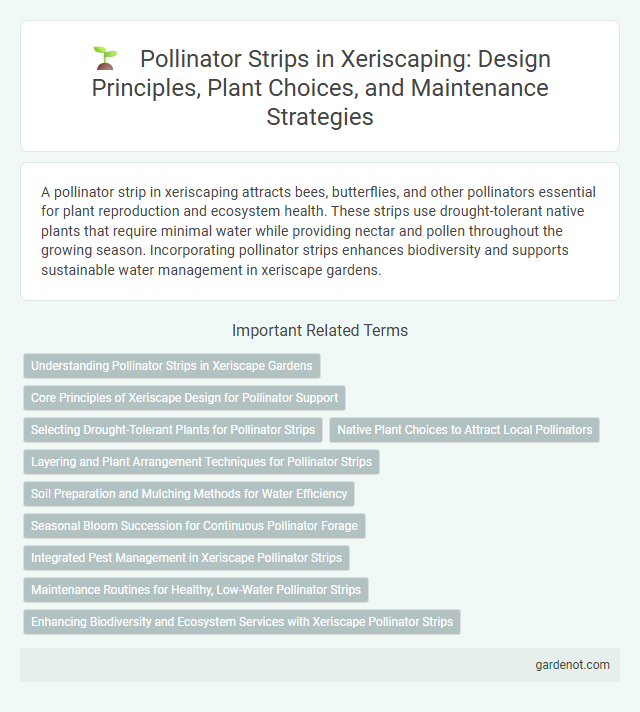A pollinator strip in xeriscaping attracts bees, butterflies, and other pollinators essential for plant reproduction and ecosystem health. These strips use drought-tolerant native plants that require minimal water while providing nectar and pollen throughout the growing season. Incorporating pollinator strips enhances biodiversity and supports sustainable water management in xeriscape gardens.
Understanding Pollinator Strips in Xeriscape Gardens
Pollinator strips in xeriscape gardens consist of drought-tolerant, native flowering plants designed to attract and support bees, butterflies, and other essential pollinators. These strips improve ecosystem health by enhancing pollination, increasing biodiversity, and conserving water through efficient plant selection. Incorporating pollinator strips promotes sustainable gardening practices that align with xeriscape principles, optimizing resource use while fostering habitat for beneficial insects.
Core Principles of Xeriscape Design for Pollinator Support
Pollinator strips in xeriscape design emphasize selecting native, drought-tolerant plants that provide continuous bloom cycles to support bees, butterflies, and other pollinators year-round. Integrating diverse floral species creates layered habitats essential for foraging and nesting, enhancing ecological resilience within arid landscapes. Strategic placement minimizes water use and maximizes sunlight exposure, aligning with xeriscape principles of water conservation and sustainable garden management.
Selecting Drought-Tolerant Plants for Pollinator Strips
Selecting drought-tolerant plants for pollinator strips enhances water conservation while supporting essential pollinator species such as bees and butterflies. Species like lavender, salvia, and black-eyed susan thrive in xeriscape conditions, providing abundant nectar and pollen during dry periods. Incorporating native, drought-resistant plants ensures sustained pollinator activity and resilience in xeriscape landscapes.
Native Plant Choices to Attract Local Pollinators
Incorporating native plant choices such as purple coneflower, black-eyed Susan, and milkweed in a pollinator strip enhances local biodiversity by attracting native bees, butterflies, and hummingbirds. These drought-tolerant plants thrive in xeriscape environments, ensuring minimal water use while providing essential nectar and pollen sources. Selecting region-specific native species supports pollinator health and promotes ecological balance within sustainable landscapes.
Layering and Plant Arrangement Techniques for Pollinator Strips
Layering and plant arrangement techniques in pollinator strips enhance biodiversity by incorporating sequential height variations and bloom times, creating habitats that support diverse pollinator species year-round. Strategic placement of native wildflowers, grasses, and shrubs in dense clusters maximizes nectar and pollen availability while providing shelter and nesting sites. Effective layering optimizes sunlight exposure and moisture retention, crucial for sustaining healthy pollinator populations within xeriscaped landscapes.
Soil Preparation and Mulching Methods for Water Efficiency
Effective soil preparation for pollinator strips involves loosening compacted soil to enhance aeration and water infiltration, promoting healthy root development. Applying organic mulch such as shredded bark or straw conserves soil moisture, reduces evaporation, and suppresses weed growth, directly improving water efficiency. Utilizing mulch with high water retention capacity optimizes irrigation efforts, ultimately supporting sustainable xeriscape practices and resilient pollinator habitats.
Seasonal Bloom Succession for Continuous Pollinator Forage
A pollinator strip designed with seasonal bloom succession ensures continuous forage for bees, butterflies, and other pollinating insects throughout the growing season. Selecting a diverse mix of native plants that bloom from early spring to late fall supports sustained pollinator health and biodiversity. Proper planning in xeriscape landscapes maximizes water efficiency while providing essential nectar and pollen resources over time.
Integrated Pest Management in Xeriscape Pollinator Strips
Integrated Pest Management (IPM) in xeriscape pollinator strips emphasizes using biological control, habitat diversity, and selective organic pesticides to minimize pest damage while preserving beneficial insects. Incorporating native flowering plants supports pollinator health and enhances natural predator populations, reducing the need for chemical interventions. Regular monitoring and habitat management are critical to maintaining ecological balance and promoting sustainable pest control in xeriscaped environments.
Maintenance Routines for Healthy, Low-Water Pollinator Strips
Maintaining healthy, low-water pollinator strips in xeriscape landscapes involves regular monitoring of soil moisture and minimal irrigation to promote drought tolerance. Periodic weeding and selective pruning of native, drought-resistant plants help sustain plant vigor and reduce competition for limited water resources. Mulching with organic materials preserves soil moisture and suppresses weeds, ensuring a robust habitat for pollinators with minimal water use.
Enhancing Biodiversity and Ecosystem Services with Xeriscape Pollinator Strips
Xeriscape pollinator strips incorporate drought-tolerant native plants that provide essential nectar and pollen resources, enhancing biodiversity by supporting a wide range of pollinators such as bees, butterflies, and hummingbirds. These strips improve ecosystem services, including pollination of nearby crops and natural vegetation, which promotes healthy plant reproduction and sustainable food webs. Integrating xeriscape pollinator strips in landscape design mitigates water use while fostering resilient habitats that contribute to overall ecosystem stability.
Pollinator strip Infographic

 gardenot.com
gardenot.com